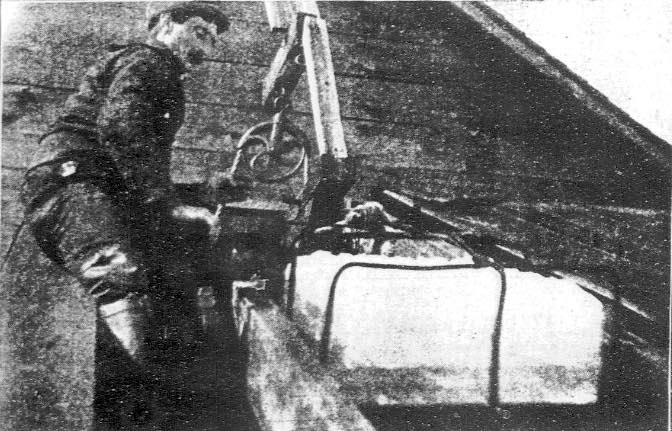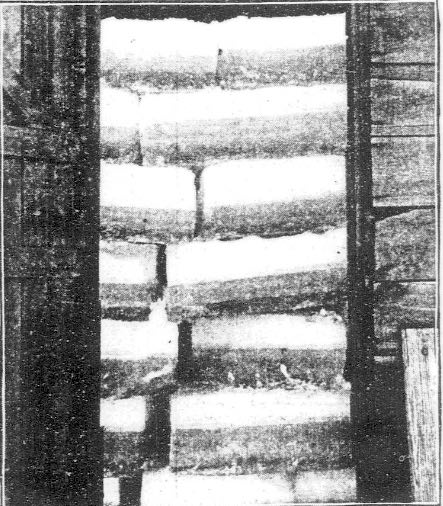
Before there were freezers, there were icehouses. The early icehouses were built underground. Later, they were insulated and built above ground. Eventually, electricity was introduced, making the old icehouses incredibly dangerous.

Electric Shock
The 1920s and 1930s saw a boon in icehouse accidents. The culprit? Electricity.
Electrical wiring was still fairly new in homes and businesses, and most people did not have the immediate knowledge that water and ice conducts electricity.
For example, in 1927, Donald McKinnon was packing the meat into the butcher shop’s ice house when he got a nasty shock. He had noticed ice melting onto some of the meat and went to move the dripping ice block. He placed a hand on the ice and could not pull himself away.
Fortunately, another employee saw what was happening and did his best to unlatch the man from the charged ice block. Once pulled free, both men went crashing onto the ground. Donald was taken to the hospital for both the electrical shock and for face injuries that occurred after he was freed.
Another butcher in 1929 was not so lucky. Hubert Paine came in contact with a live wire inside his icehouse. For two hours after his severe electrocution, doctors attempted to “restore animation” through artificial respiration, but were unsuccessful.
Fires
While there was always the chance of getting electrocuted in the “modern” icehouses, sometimes those electrical wires would cause fires.
That’s what happened in 1932 at the Hotel Toronto. A short circuit happened in an electrical wire inside the icehouse. The hotel owner attempted to put out the fire, but was unsuccessful. The fire brigade came and hosed down the flames before sealing off the icehouse.
The incident could have been a total disaster because the icehouse was beneath the main part of the hotel which was crowded with guests at that time.
Frozen To Death
Has anyone ever gotten trapped in their own icehouse? You bet.
In 1946, Saul H. Perry, the owner of an ice cream company in Connecticut, was found frozen to death in one of his own icehouses.
Perry performed daily inspections of his company next door to him home. The only trouble was that he forgot that the lock on the freezer was broken and the door could not be opened from the inside.
After being shut in, Perry naturally panicked. He attempted to pick the lock with a fountain pen, a pencil, and had even ripped out the electrical wiring from the walls in an attempted to get out of the icehouse. Finally, he ripped up the cardboard boxes and attempted to light a fire in the negative 40 degree F unit.
His body was found frozen the next day.

Caught On The Ice Saw
Frank Evans from South Africa came to Sydney, Australia and began work as a police officer. For his final assignment in 1900, he was placed on quarantine duty at the Fresh Food and Ice Company.
Evans eventually gave into his curiosity about the ice house and entered the premises to watch the men cut the ice blocks with large, circular saws. When he stooped down inside the building, his uniform’s cape got caught on the saw’s teeth and he was pulled into the saw.
The poor man gave out a cry, but was sawn almost entirely in half before the other men realized what was happening. The power to the blade was turned off, but it had already “travelled in a slanting direction across the back from the shoulder to the waist, and sever[ed] [the] spinal column.”
Hanged By Accident
Gustave Guisky was known as a bit of a prankster. At the age of eighteen, he was no doubt getting into all sorts of foolish trouble in New York City, but his last bit of trouble happened in 1876.
Guisky worked at a butcher shop and, all abuzz about a recent hanging, he openly mused about what it was like to be hanged. He was so curious that he grabbed some clothesline, told his boss he was going to conduct an experiment, and went into the icehouse.
After ten minutes had passed, the boss went to find the young man. He opened the door to the icehouse and found Guisky hanging from a hook inside. The police believe he made the noose, tied it to the hook, and then placed his head through the loop. The young man must have then leaned forward to feel the sensation of being hung, but he lost his footing on the slick, icy floor and was strangled.

